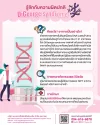
ตรวจนิฟตี้ (NIFTY TEST) คืออะไร?
การตรวจนิฟตี้ (NIFTY TEST) คือ การตรวจดีเอ็นเอของทารกที่ปะปนอยู่ในเลือดของมารดา (Cell-free fetal DNA) โดยจะเก็บตัวอย่างเลือดจากมารดาไปส่งตรวจทางห้องปฏิบัติการเพื่อหาความผิดปกติของโครโมโซมที่อาจเกิดขึ้น จัดเป็นหนึ่งในวิธีตรวจคัดกรองดาวน์ซินโดรมที่มีความแม่นยำสูงถึง 99% และไม่มีความเสี่ยงทำให้เกิดภาวะแท้งด้วย
การตรวจ NIFTY เหมาะสำหรับใครบ้าง ?
- คุณแม่ตั้งครรภ์ที่มีอายุครรภ์ 10 - 24 สัปดาห์
- คุณแม่ตั้งครรภ์เดี่ยว ครรภ์แฝด หรือคุณแม่อุ้มบุญ
- คุณแม่ตั้งครรภ์โดยใช้เทคโนโลยีช่วยการตั้งครรภ์
ทำไมต้องเลือกตรวจนิฟตี้ (NIFTY TEST)

14M+
จำนวนการส่งตรวจจากทั่วโลก
กว่า 14 ล้านราย

>99%
ความแม่นยำในการตรวจคัดกรอง
ดาวน์ซินโดรมมากกว่า 99%

0%
ไม่มีความเสี่ยง
ต่อการแท้งของลูกน้อย

10
เหมาะกับอายุครรภ์ตั้งแต่ 10 สัปดาห์
และเจาะเลือดแม่เพียง 10 มล. เท่านั้น

5-7
รายงานผลภายใน
5-7 วัน

147,000
มีงานวิจัยขนาดใหญ่ที่สุด จากหญิงตั้งครรภ์ จำนวน 147,000 ราย
ตรวจนิฟตี้ (NIFTY TEST) มีกี่แบบ?
ในปัจจุบัน แพ็กเกจตรวจนิฟตี้ (NIFTY TEST) มีทั้งหมด 4 แบบ ได้แก่ NIFTY PRO ,NIFTY Core ,NIFTY Focus ,NIFTY Twin
ซึ่งแต่ละแบบจะมีรายการตรวจที่แตกต่างกัน คุณแม่ตั้งครรภ์สามารถเลือกแพ็กเกจตรวจที่ตอบโจทย์ความต้องการของตัวเองได้เลย
แพ็กเกจนิฟตี้

Trisomies
- Trisomy 21 (ดาวน์ซินโดรม)
- Trisomy 18 (เอ็ดเวิร์ดซินโดรม)
- Trisomy 13 (พาทัวซินโดรม)
รายงานผลเพศทารก
- ชาย/หญิง
Trisomies
- Trisomy 9
- Trisomy 16
- Trisomy 22
- Trisomy อื่นๆ
ความผิดปกติที่เกิดจากโครโมโซมเพศ
- Monosomy X (เทอร์เนอร์ซินโดรม)
- XXY (ไคลน์เฟลเตอร์ซินโดรม)
- XXX (ภาวะเกินมาของโครโมโซม X)
- XYY (จาค็อบส์ซินโดรม)
Deletion / Duplication
- 92 รายการ ของโครโมโซมที่มีการขาดหายไปหรือเพิ่มขึ้นมา

Trisomies
- Trisomy 21 (ดาวน์ซินโดรม)
- Trisomy 18 (เอ็ดเวิร์ดซินโดรม)
- Trisomy 13 (พาทัวซินโดรม)
รายงานผลเพศทารก
- ชาย/หญิง
Trisomies
- Trisomy 9
- Trisomy 16
- Trisomy 22
- Trisomy อื่นๆ
ความผิดปกติที่เกิดจากโครโมโซมเพศ
- Monosomy X (เทอร์เนอร์ซินโดรม)
- XXY (ไคลน์เฟลเตอร์ซินโดรม)
- XXX (ภาวะเกินมาของโครโมโซม X)
- XYY (จาค็อบส์ซินโดรม)

Trisomies
- Trisomy 21 (ดาวน์ซินโดรม)
- Trisomy 18 (เอ็ดเวิร์ดซินโดรม)
- Trisomy 13 (พาทัวซินโดรม)
รายงานผลเพศทารก
- ชาย/หญิง
ความผิดปกติที่เกิดจากโครโมโซมเพศ
- Monosomy X (เทอร์เนอร์ซินโดรม)
- XXY (ไคลน์เฟลเตอร์ซินโดรม)
- XXX (ภาวะเกินมาของโครโมโซม X)
- XYY (จาค็อบส์ซินโดรม)

Trisomies
- Trisomy 21 (ดาวน์ซินโดรม)
- Trisomy 18 (เอ็ดเวิร์ดซินโดรม)
- Trisomy 13 (พาทัวซินโดรม)
รายงานผลเพศทารก
- การตรวจพบโครโมโซม Y
เปรียบเทียบประสิทธิภาพในการตรวจคัดกรองดาวน์ซินโดรม
0%
ตรวจนิฟตี้ (NIFTY TEST)
ตรวจได้ตั้งแต่อายุครรภ์
10 สัปดาห์
0%
SERUM INTEGRATED SCREENING
ตรวจได้ตั้งแต่อายุครรภ์
15 สัปดาห์
0%
QUAD SCREENING
ตรวจได้ตั้งแต่อายุครรภ์
15 สัปดาห์
0%
FIRST TRIMESTER SCREENING
ตรวจได้ตั้งแต่อายุครรภ์
10 สัปดาห์
ขั้นตอนการตรวจนิฟตี้ (NIFTY TEST)

ขั้นตอน 1
เข้ารับคำปรึกษาเกี่ยวกับ
การตรวจจากแพทย์

ขั้นตอน 2
เจาะเลือด 8-10 มิลลิลิตร

ขั้นตอน 3
นำส่งตัวอย่างไปยัง
ห้องปฏิบัติการเพื่อวิเคราะห์

ขั้นตอน 4
รายงานผลภายใน
5-7 วัน
ประโยชน์ที่จะได้รับจากการตรวจนิฟตี้ (NIFTY TEST)
ความแม่นยำมากกว่า 99%
การตรวจคัดกรองดาวน์ซินโดรมด้วยการ
ตรวจนิฟตี้ (NIFTY TEST) มีความแม่นยำมากกว่า 99% ที่สำคัญยังสามารถตรวจพบความผิดปกติของโครโมโซมอื่น ๆ ได้ด้วย
รับประกันความผิดพลาด
ในกรณีที่ผลลบลวง (False negative) รับเงินประกันสูงสุดถึง 2 ล้านบาท
มีประกันค่าเจาะน้ำคร่ำ
ในกรณีที่ผลความเสี่ยงสูง หรือตรวจพบความผิดปกติ นิฟตี้มีวงเงินสนับสนุนค่าเจาะน้ำคร่ำให้สูงสุดถึง 25,000 บาท
รู้เพศทารกรวดเร็ว
ทราบผลเพศทารกได้ตั้งแต่อายุครรภ์ 10 สัปดาห์ ซึ่งเร็วกว่า
การอัลตราซาวด์ที่ตรวจได้ตอนอายุครรภ์ประมาณ 18-21 สัปดาห์
มีพาร์ทเนอร์ทั่วประเทศ
สามารถเข้ารับบริการตรวจนิฟตี้ (NIFTY TEST) จากสถานพยาบาล
ชั้นนำทั่วประเทศ
วารสารวิชาการ
Zhang, H., et al. (2015). Non-invasive prenatal testing for trisomies 21, 18 and 13: clinical experience from 146,958 pregnancies. Ultrasound Obstet Gynecol, 45(5), 530-538. doi: 10.1002/uog.14792
Lau, T. K., el at. (2013). Non-invasive prenatal screening of fetal Down syndrome by maternal plasma DNA sequencing in twin pregnancies. The Journal of Maternal-Fetal and Neonatal Medicine 2013 Mar;26(4): 434-7
- หน้าหลัก หน้าหลัก
- ผลิตภัณฑ์และบริการ ผลิตภัณฑ์และบริการ
- นักลงทุนสัมพันธ์ นักลงทุนสัมพันธ์
- ข่าวประชาสัมพันธ์ ข่าวประชาสัมพันธ์
- ตรวจมะเร็ง ตรวจมะเร็ง



